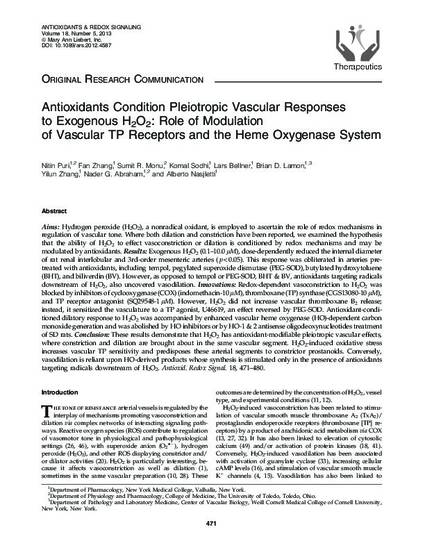
Aims: Hydrogen peroxide (H(2)O(2)), a nonradical oxidant, is employed to ascertain the role of redox mechanisms in regulation of vascular tone. Where both dilation and constriction have been reported, we examined the hypothesis that the ability of H(2)O(2) to effect vasoconstriction or dilation is conditioned by redox mechanisms and may be modulated by antioxidants.
Results: Exogenous H(2)O(2) (0.1-10.0 μM), dose-dependently reduced the internal diameter of rat renal interlobular and 3rd-order mesenteric arteries (p<0.05). This response was obliterated in arteries pretreated with antioxidants, including tempol, pegylated superoxide dismutase (PEG-SOD), butylated hydroxytoluene (BHT), and biliverdin (BV). However, as opposed to tempol or PEG-SOD, BHT & BV, antioxidants targeting radicals downstream of H(2)O(2), also uncovered vasodilation.
Innovations: Redox-dependent vasoconstriction to H(2)O(2) was blocked by inhibitors of cyclooxygenase (COX) (indomethacin-10 μM), thromboxane (TP) synthase (CGS13080-10 μM), and TP receptor antagonist (SQ29548-1 μM). However, H(2)O(2) did not increase vascular thromboxane B(2) release; instead, it sensitized the vasculature to a TP agonist, U46619, an effect reversed by PEG-SOD. Antioxidant-conditioned dilatory response to H(2)O(2) was accompanied by enhanced vascular heme oxygenase (HO)-dependent carbon monoxide generation and was abolished by HO inhibitors or by HO-1 & 2 antisense oligodeoxynucleotides treatment of SD rats.
Conclusions: These results demonstrate that H(2)O(2) has antioxidant-modifiable pleiotropic vascular effects, where constriction and dilation are brought about in the same vascular segment. H(2)O(2)-induced oxidative stress increases vascular TP sensitivity and predisposes these arterial segments to constrictor prostanoids. Conversely, vasodilation is reliant upon HO-derived products whose synthesis is stimulated only in the presence of antioxidants targeting radicals downstream of H(2)O(2).

The copy of record is available from the publisher at http://online.liebertpub.com/doi/abs/10.1089/ars.2012.4587. Copyright © 2012 Mary Ann Liebert, Inc. Reprinted with permission. All rights reserved.
doi: 10.1089/ars.2012.4587